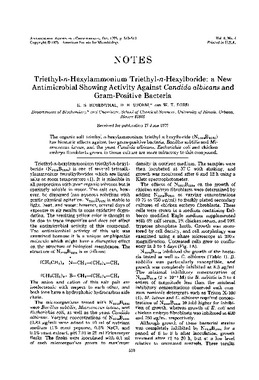| dc.contributor.author | Rosenthal, K. S. | |
| dc.contributor.author | Storm, D. R. | |
| dc.contributor.author | Ford, W. T. | |
| dc.date.accessioned | 2015-10-16T20:48:00Z | |
| dc.date.available | 2015-10-16T20:48:00Z | |
| dc.date.issued | 1975-10 | |
| dc.identifier | okds_Ford_AMAC_1975-10.pdf | |
| dc.identifier.citation | Rosenthal, K. S., Storm, D. R., & Ford, W. T. (1975). Triethyl-n-hexylammonium triethyl-n-hexylboride: A new antimicrobial showing activity against Candida albicans and gram-positive bacteria. Antimicrobial Agents and Chemotherapy, 8(4), 510-512. https://doi.org/10.1128/AAC.8.4.510 | |
| dc.identifier.uri | https://hdl.handle.net/11244/19832 | |
| dc.description.abstract | The organic salt triethyl-n-hexylammonium triethyl-n-hexylboride (N2226 B2226) has biostatic effects against two gram-positive bacteria, Bacillus subtilis and Micrococcus luteus, and the yeast Candida albicans. Escherichia coli and chicken embryo fibroblasts grown in tissue culture are more refractory to this compound. | |
| dc.format | application/pdf | |
| dc.language | en_US | |
| dc.publisher | American Society for Microbiology | |
| dc.rights | This material has been previously published. In the Oklahoma State University Library's institutional repository this version is made available through the open access principles and the terms of agreement/consent between the author(s) and the publisher. The permission policy on the use, reproduction or distribution of the material falls under fair use for educational, scholarship, and research purposes. Contact Digital Resources and Discovery Services at lib-dls@okstate.edu or 405-744-9161 for further information. | |
| dc.title | Triethyl-n-hexylammonium triethyl-n-hexylboride: A new antimicrobial showing activity against Candida albicans and gram-positive bacteria | |
| osu.filename | okds_Ford_AMAC_1975-10.pdf | |
| dc.description.peerreview | Peer reviewed | |
| dc.identifier.doi | 10.1128/AAC.8.4.510 | |
| dc.description.department | Chemistry | |
| dc.type.genre | Article | |
| dc.type.material | Text | |
